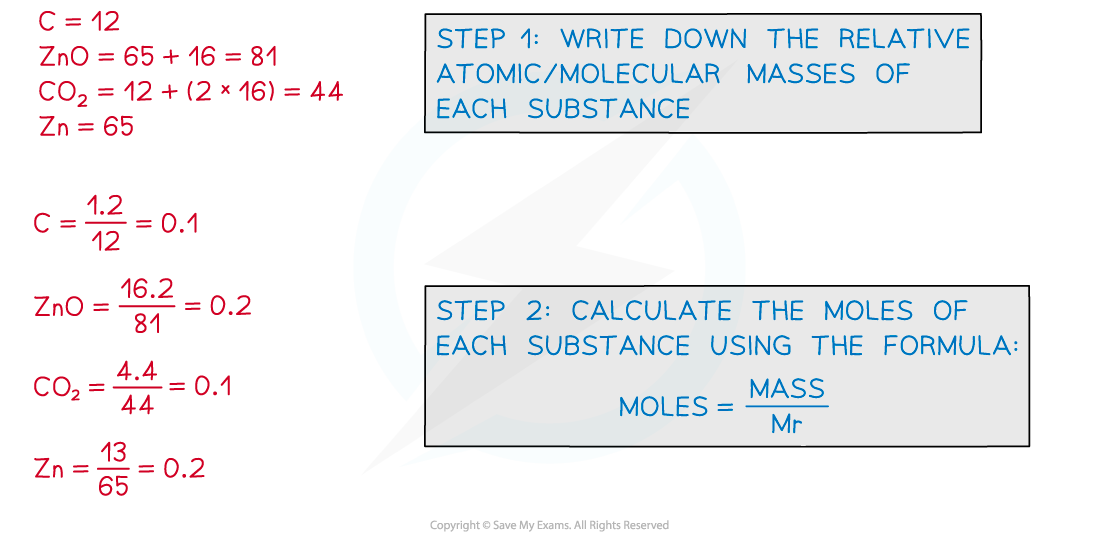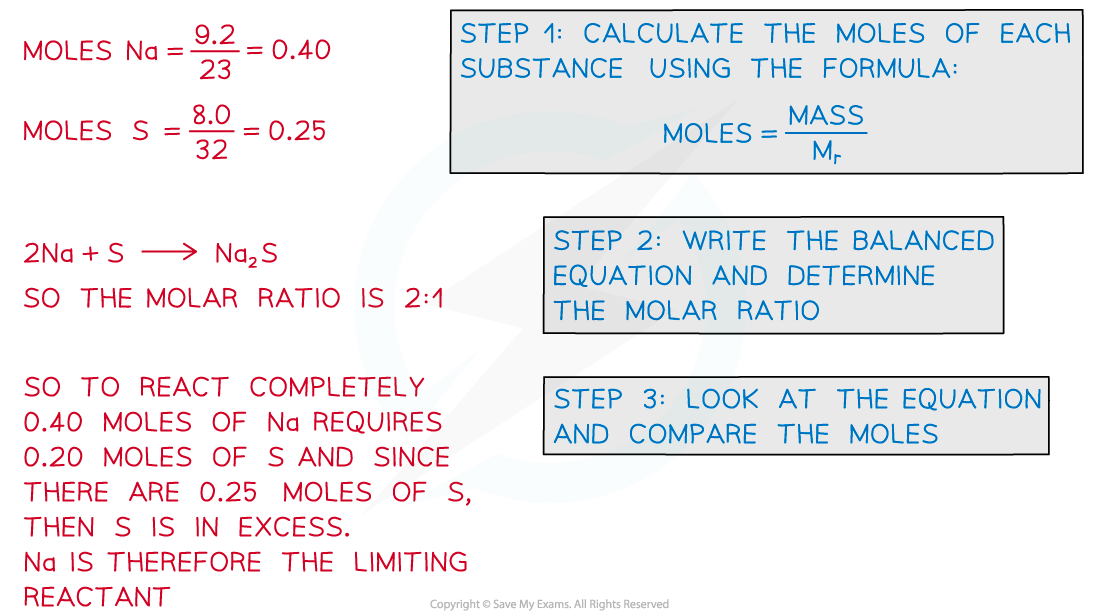Using Moles to Balance Equations (OCR GCSE Combined Science A (Gateway)) : Revision Note
Using Moles to Balance Equations
Higher Tier Only
Stoichiometry refers to the numbers in front of the reactants and products in an equation, which must be adjusted to make sure that the equation is balanced
These numbers are called coefficients (or multipliers) and if we know the masses of reactants and products, the balanced chemical equation for a given reaction can be found by determining the coefficients
First, convert the masses of each reactant and product in to moles by dividing by the molar masses using the Periodic Table
If the result yields uneven numbers, then multiply all of the numbers by the same number, to find the smallest whole number for the coefficient of each species
For example, if the resulting numbers initially were 1, 2 and 2.5, then you would multiply all of the numbers by 2, to give the whole numbers 2, 4 and 5
Then, use the molar ratio to write out the balanced equation
Worked Example
Example 1
64 g of methanol, CH3OH, reacts with 96 g of oxygen gas to produce 88 g of carbon dioxide and 72 g of water. Deduce the balanced equation for the reaction.(C = 12.0, H = 1.0, O = 16.0)
Answer
Calculate the molar masses of the substances in the equation
CH3OH = 32 g mol-1 O2 = 32 g mol-1
CO2 = 44 g mol-1 H2O = 18 g mol-1
Divide the masses present by the molar mass to obtain the number of moles
CH3OH = 64 g ÷ 32 g mol-1 = 2 mol
O2 = 96 g ÷ 32 g mol-1 = 3 mol
CO2 = 88 g ÷ 44 g mol-1 = 2 mol
H2O = 72 g ÷ 18 gmol-1 = 4 mol
The mole ratios are the same as the coefficients in the balanced equation
2CH3OH + 3O2 ⟶ 2CO2 + 4H2O
Worked Example
Example 2
A student reacts 1.2 g of carbon with 16.2 g of zinc oxide. The resulting products are 4.4 g of carbon dioxide and 13 g of zinc. Determine the balanced equation for the reaction.
Answer

Examiner Tips and Tricks
The molar ratio of a balanced equation gives you the ratio of the amounts of each substance in the reaction.
Limiting Reactants
A chemical reaction does not go on indefinitely and stops when one of the reagents is used up
The reagent that is used up first is the limiting reactant, as it limits the duration of the reaction and hence the amount of product that a reaction can produce
The one that is remaining is the excess reactant
The limiting reagent is the reactant which is not present in excess in a reaction
The amount of product obtainable is therefore directly proportional to the amount of the limiting reagent added at the beginning of a reaction
So, if you use half of the limiting reagent then you will get half of the product, provided the other reagents are present in excess. If you double the amount of the limiting reagent then you obtain double the amount of product
Determining the Limiting Reactant
In order to determine which reactant is the limiting reagent in a reaction, we have to consider the amounts of each reactant used and the molar ratio of the balanced chemical equation
When performing reacting mass calculations, the limiting reagent is always the number that should be used, as it indicates the maximum possible amount of product that can form
Once all of a limiting reagent has been used up, the reaction cannot continue
The steps are:
Convert the mass of each reactant into moles by dividing by the molar masses
Write the balanced equation and determine the molar ratio
Look at the equation and compare the mole
Worked Example
In a reaction to produce sodium sulfide, Na2S, 9.2 g of sodium is reacted with 8.0 g of sulfur.
Which reactant is in excess and which is limiting?
Answer

Examiner Tips and Tricks
For a reactant to be present in excess, there only needs to be slightly more of it present than the other reactant, as determined from the molar ratio. In a two-reactant system, if one reactant is in excess then the other is by default the limiting reagent.
A common error is to determine the limiting reactant as the reactant with the least amount of moles in the molar ratio. This is incorrect as the masses of each reactant must also be considered.

You've read 0 of your 5 free revision notes this week
Unlock more, it's free!
Did this page help you?
